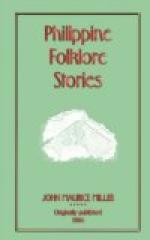Then suddenly there was a fearful noise and the whole mountain top flew high in the air, leaving an immense hole from which poured fire and smoke.
The people fled and did not stop until they were far away. Harisaboqued had kept his word.
Many years have come and gone, but the mountain is bare and the smoke still rolls out of the mountain top. Villages have sprung up along the sides, but no tobacco is grown on the mountain. The people remember the tales of the former great crops and turn longing eyes to the heights above them, but they will have to wait. Harisaboqued is still smoking his tobacco.
The Pericos
Throughout the Visayan islands almost every family owns a pericos, kept as American children keep canary birds. The pericos is about the size and color of a Crow, but has a hard white hood that entirely covers its head. The people teach it but one phrase, which it repeats continually, parrot fashion. The words are, “Comusta pari? Pericos tao.” (How are you, father? Parrot-man.) “Pari” means padre or priest. The people address the pericos as “pari” because its white head, devoid of feathers, seems to resemble the shaven crowns of the friars and native priests.
I
In his small wooden box
That hangs on the wall
Sits a queer-looking bird
That in words sounds his call.
From daybreak to twilight
His cry he repeats,
Resting only whenever
He drinks or he eats.
He never grows weary,—
Hear! There he goes now!
“Comusta pari?
Pericos tao.”
II
And all the day long
You can hear this strange cry:
“How are you, father?
A parrot-man I.”
He sits on his perch,
In his little white cap,
And pecks at your hand
If the cage door you tap.
Now give him some seeds,
Hear him say with a bow,
“Comusta pari?
Pericos tao.”
III
Poor little birdie!
How hard it must be
To sit there in prison
And never be free!
I’ll give you a mango,
And teach you to say
“Thank you,” and “Yes, sir,”
And also “Good day.”
You’ll find English as easy
As what you say now,
“Comusta pari?
Pericos tao.”
IV
I’ll teach you “Good morning”
And “How do you do?”
Or “I am well, thank you,”
And “How are you too?”
“Polly is hungry” or
“It’s a fine day.”
These and much more
I am sure you could say.
But now I must go,
So say with your bow,
“Comusta pari?
Pericos tao.”
Quicoy and the Ongloc
This story is known generally in the southern Islands. The Ongloc is feared by the children just as some little boys and girls fear the Bogy Man. The tale is a favorite one among the children and they believe firmly in the fate of Quicoy.




